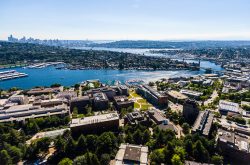
Leveraging the tectonic laboratory of the Cascadia subduction zone, the University of Washington today announced a new effort to best understand how to study and live with the threats of earthquakes, tsunamis, volcanos, landslides and other seismic hazards. Dubbed the GeoHazards Initiative, the interdisciplinary work aims to develop and promote the adoption of early detection systems both on land and at sea to help prevent the loss of human life and property.
“The vision ultimately is for an integrated initiative that will span geohazards and their impact on society,” said Harold Tobin, the newly named Paros Endowed Chair in Seismology and Geohazards. “A big goal of this new effort is to bring together the strengths of different pieces of the UW research community to tackle all these problems in a truly novel way that can help us make progress on understanding all of those hazardous events and how to mitigate their damaging effects.”
The initiative’s starting place will be focused on sensors, both on land and at sea, that can help scientists better understand seismic events and how to detect them as they begin, and even to determine times and places where risk may be heightened.
“We need to be able to detect movement deep beneath the ground both on land and under the ocean equally, in order to take this to the next level,” Tobin said, who already is the Washington state seismologist, directs the Pacific Northwest Seismic Network, and is a professor in the Department of Earth & Space Sciences. “And that’s traditionally been two different realms here at the university. But really it’s all an Earth process and we need to work together.”
Tobin will initially partner with researchers in the UW School of Oceanography and the UW Applied Physics Lab, with hopes to bring other parts of the university in as the research progresses.
“Offshore sensors can help provide early warning for earthquakes and tsunamis, and help advance scientific understanding of what’s happening under the ocean in the Cascadia subduction zone,” said William Wilcock, the Jerome M. Paros Endowed Chair in Sensor Networks and professor in the School of Oceanography, who will also work on the GeoHazards Initiative.
Read more at UW News »
